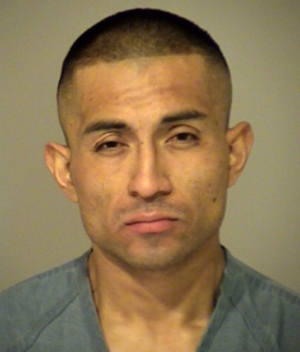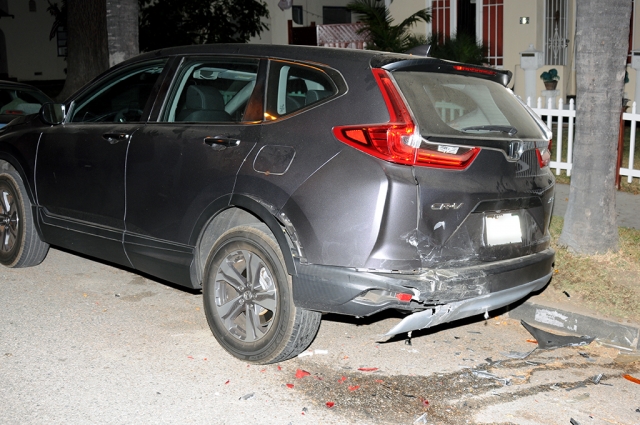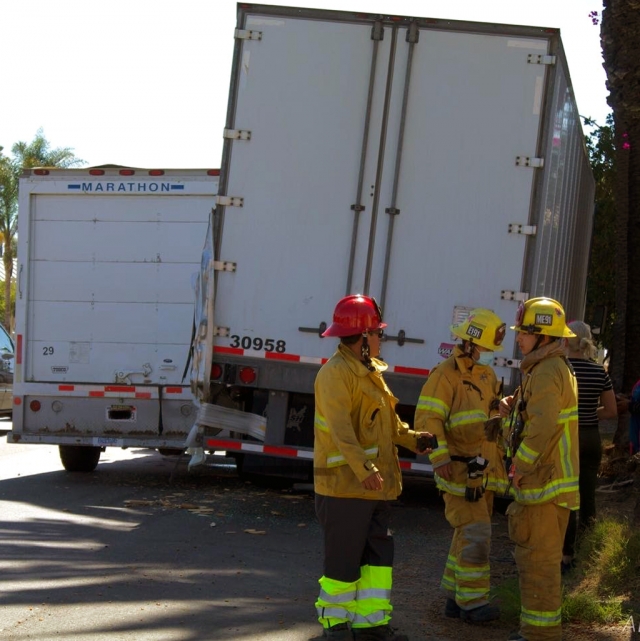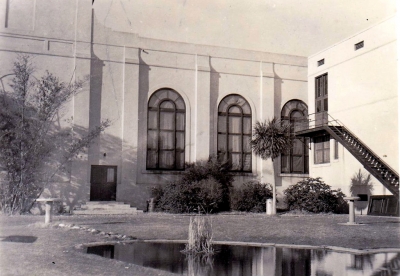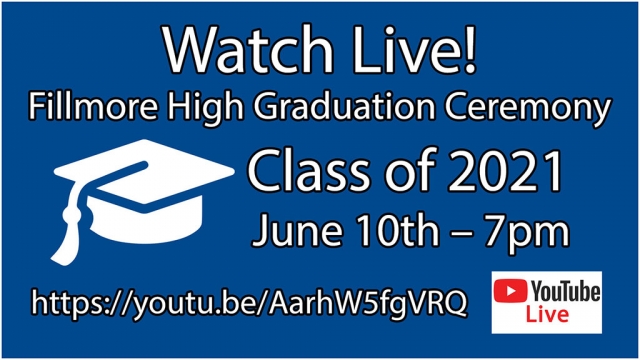|
By Anonymous — Thursday, June 17th, 2021
Fillmore High School hosted their 2021 Graduation in traditional style this year at the Fillmore High football stadium. Although they were limited as to attendance because of the COVID-19 pandemic, they were still able to make graduation a success. On Thursday, June 10th at 7pm, FHS seniors took their walk across the stage to say their final goodbyes to Fillmore High. You can view the entire graduation using this YouTube link: https://www.youtube.com/watch?v=AarhW5fgVRQ |
|
By Anonymous — Thursday, June 17th, 2021
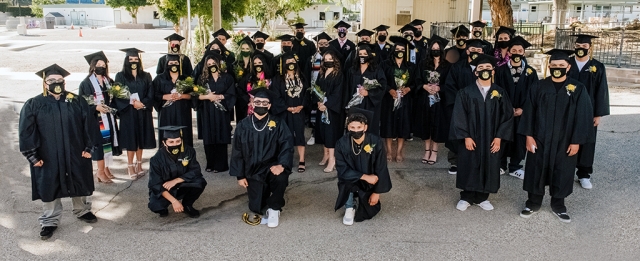 On Thursday, June 10th, Sierra High School hosted their 2021 Graduation ceremony. This yearâs ceremony took place in front of the District Office while abiding by COVID-19 protocols; graduation was a success! Pictured is the Sierra High School Graduating Class of 2021. Enlarge Photo |
|
By Anonymous — Thursday, June 17th, 2021
33-year-old Jahwi Angeles-Ortega of Oxnard was arrested in March 2021 for vehicle theft in Moorpark with a toddler inside, and was apprehended with a assistance of multi-sheriff departments, including Fillmore Patrol stations. He was sentenced to two years probation and 240 days in County Jail. He was charged with felony vehicle theft, misdemeanor receiving stolen property, and misdemeanor prowling. He received 140-day credit for the 240 days as time already served plus "work time-good time" credits. He will be required to undergo substance abuse counseling and treatment among several other restrictions and requirements. At the time of his arrest, he had multiple outstanding warrants, was arrested for vehicle theft, and kidnapping but prosecutors never filled the kidnapping charge. |
|
By Anonymous — Thursday, June 17th, 2021
 The City of Fillmore announced there will be a fireworks display this year. This yearâs display will be held on Saturday, July 3rd, 2021 at the Fillmore Middle School baseball field and is expected to begin at 9pm. Pictured is a photo from a fireworks display in past years. Have a Safe 4th of July! Enlarge Photo |
|
By Anonymous — Thursday, June 17th, 2021
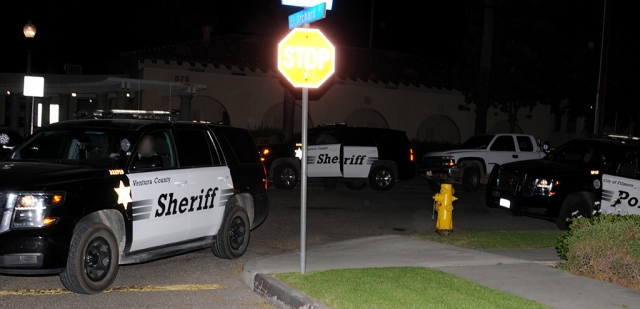 On Monday, June 8th, at 9:45pm, multiple police units responded to a hit and run incident at the corner of Orchard and First Street involving two parked vehicles. A Toyota Prius sustained major front-end damage, and a Honda CRV sustained rear end damage. No further information was given at the time of the incident. Enlarge Photo |
|
By Anonymous — Thursday, June 17th, 2021
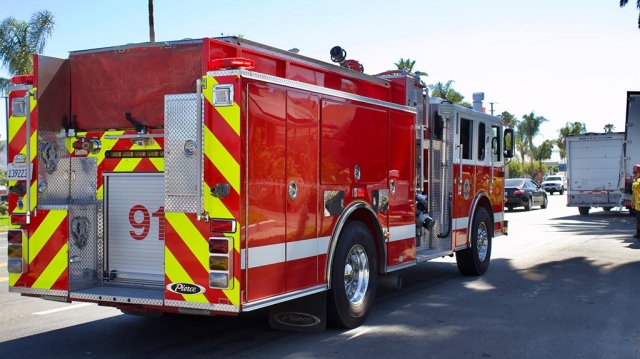 On June 13th, 2021, at 3:42pm, Fillmore Police, City Fire and AMR Paramedics were dispatched to a traffic collision in the area of Olive Street and Ventura Street. Arriving fire crews reported a box truck and a semi involved, with all occupants out. No injuries were reported. Cause of the crash is under investigation. Photos courtesy Angel Esquivel-AE News. Enlarge Photo |
 A shot lead bullet (left) and its fragments compared to a modern copper monolithic bullet (right). Many are switching to non-lead for its performance and safety for scavenging wildlife. Courtesy Hunting and Conservation Outreach, Great Basin Institute, Ventura Office. Enlarge Photo By Anonymous — Thursday, June 17th, 2021
Summer is finally here, a time when California deer hunters are dreaming about filling their empty freezers and when ranchers are seeing a proliferation of new ground squirrel burrows plaguing their fields. Most hunters and ranchers alike use a firearm to either provide their families with wholesome game meat, or reduce the population of destructive species. In 2020 both these groups saw Assembly Bill 711 (2013) in effect for its first full year, banning the use of lead ammunition for hunting of wildlife. The legislation was aimed at addressing lead poisoning deaths in scavenging wildlife, most notably the California condor. Multiple studies have traced a link between the use of lead ammunition and mortality in raptor populations, including bald and golden eagles. Lead has deep historical usage in hunting projectiles since it is dense, malleable, and easily mined but it tends to remain in the environment for many years. Shot lead bullets can fragment hundreds of times into an animal, especially when placed on hard tissue. The microscopic pieces left behind in unrecovered game, gut piles, or dispatched livestock become available to scavengers who unfortunately can succumb to lead poisoning. The new restrictions aside, hunters and ranchers continue to contribute to conservation. Revenue from license and gun/ammo sales are crucial sources of funding for wildlife conservation, while the modern diets of scavengers like the condor rely almost entirely on cattle and large terrestrial game. Making the switch to non-lead provides a clean source of food for condors and other scavenging raptors that frequent the area around Fillmore, and hunters and ranchers who shoot with non-lead are some of the most important stakeholders in the recovery of Californiaâs raptor populations. Center and Rimfire As a previous Gazette contributor pointed out, you first need to understand how alternative metals fly, then test how new rounds perform with your particular firearm. The difference between densities of lead and copper (the most common non-lead option) alters the flight path and may require resighting. Copper bullets may come with a polymer tip to improve accuracy and expansion of their copper petals such as the Barnes TTSX, Hornady GMX, Federal Trophy Copper, or Nosler E-Tip, while others have an exposed hollow point such as Sig Sauerâs Copper Elite, Barnes TSX, and the Federal Copper HP. The monolithic design undeniably has better weight retention and penetration which is crucial for quickly dispatching tough species like feral hogs or large livestock. They are all manufactured with strict specifications to consistently expand and release their energy on target. For ranchers and hunters conducting nuisance species management or harvesting furbearers, an appropriately sized round may be available as a frangible. Frangibles are copper-jacketed and filled mainly with powdered copper alloy core to create a single entrance and release their energy rapidly. Options such as the Barnes Varmint Grenade, Hornady NTX, and Nosler Ballistic Tip Lead Free are excellent choices. The offerings for the old iron sight rimfire rifle now include Hornady NTX, CCI Copper-22, and Norma ECO. Although these lead alternative options are less dense and destabilize in flight at longer ranges, this is not much concern for standard rimfire hunting conditions. Shotgun The lead-free options available for the various gauges and applications of shotguns are too numerous to mention here but the alternative metals- steel, bismuth, tungsten, or alloys of them should be tested to identify if they are conducive to your firearm. At the end of the day the firearm chooses the best performing ammunition, not the shooter. Check that your gun is rated for these harder alternatives as older models and Damascus steel barrels can get damaged. Shot sizes will also change. Steel, as a rule of thumb, should be shot one to two sizes larger than a shooterâs previous lead load, while tungsten can be shot 3 or 4 sizes smaller. A modification of choke size may be in order regardless. Note- if you find small upland loads like size 6 steel right now, congratulations on winning the California lottery. If competing for rifle and shotgun ammo is running you ragged, many hunters are now switching to air rifles. Unlike the farmâs old Red Ryder, modern designs of pellet rifles can fire a projectile in excess of 1500 feet per second. Pellet alternatives include copper and alloys of tin, bismuth, and zinc that are capable of performing better than lead counterparts. Researching larger calibers like .22 or .25 can help you find a gun and pellet combination that matches your needs, and the best part is that they both ship without a background check right to your door! Some popular options there are Haendler & Natermann H&N Baracuda Green, Predator GTO Lead-free, and Daisy Precision Max Flat Lead-free. Practicing at varying distances can increase confidence in your bullet choice and lead to success in any scenario. By researching rounds you see on the shelf, thoroughly cleaning guns to remove metal residue, testing multiple options, or buying a rifle with a higher twist rate you can ensure your aim stays true and your target goes down humanely. Ammunition shortages are still very real so it is in the best interest to start buying your ammunition several months ahead of season and get cozy with your local purveyor. Hunters and ranchers- take pride in the knowledge that you are contributing to the propagation and recovery of scavenging species by shooting non-lead ammunition. You are making the recovery of species such as the California condor possible, all while continuing the sportsmanâs tradition of conservation. If you would like to learn more about the why and how of switching, visit www.huntingwithnonlead.org. |
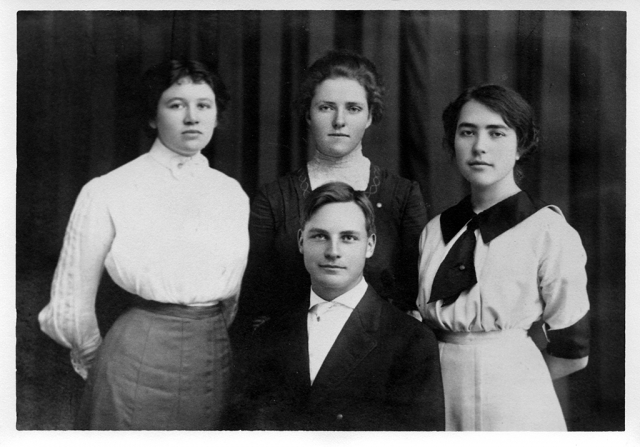 Fillmoreâs first graduating class (l-r) Mary Cummings, Albert Wiklund, Sarah King, and Mabel Arthur. Photos courtesy Fillmore History Museum. Enlarge Photo By Anonymous — Thursday, June 17th, 2021
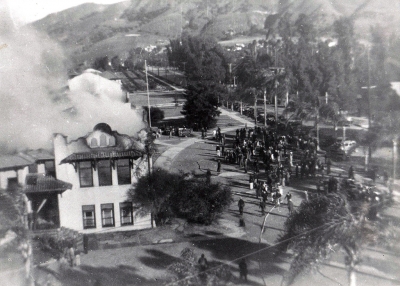 The 1937 Junior High School fire. The cause of the fire was unknown. Both high school and junior high students used the high school building for the next two years after the fire. Enlarge Photo 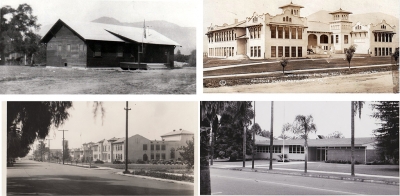 Fillmore High School throughout the years. (Clockwise from upper left) 1910 first high school at 2nd and Saratoga, 1911 high school at 2nd and Central, 1925 high school on Central circa 1965, and the current high school's administration building. Enlarge Photo Congratulations to the Class of 2021. This had to be one of the strangest school years in the history of Fillmore High School. So what was the earliest history of Fillmore High School? The first high school opened in 1909 in a house built by Hattie (Mrs. George N.) King on the southwest corner of 2nd and Saratoga. Before that, any student wanting âhigherâ education had to go to high school in Santa Paula. The building on Saratoga was only used for one year. Haines Hardison, Fillmoreâs third mayor, purchased the building and converted it into a dwelling. In 1910 a new high school was built on 2nd and Central Avenue. The first graduating class was made up of Mary Cummings, Albert Wiklund, Sarah King and Mabel Arthur. The early Copa de Oros not only reported on the doings of the students, but also reported on alumni. According to the 1923 Copa de Oro, Mabel Arthur (now Cummings, she had married Maryâs older brother) was living in Long Beach as was Albert Wiklund. Sarah King (of the Piru King Family) had graduated from USC and was a missionary in Rhodesia, Africa. Mary Cummings (Jones) had sadly succumbed in the influenza pandemic as had one of the following yearâs graduates, Vinnie Hinckley. Speaking of the Copa de Oro, the first âannualâ was printed in 1913 and called âEl Picadillo,â meaning âHashâ. A contest was staged by the student body to find a new name for the annual. The prize would be three free annuals. Many names were submitted, but the winning name was âCopa de Oroâ submitted by a freshman, Edith Moore. Edith was known as Edith Moore Jarrett when she taught Spanish at the High School, wrote a Spanish text which was used country wide for many years and founded the Fillmore Historical Museum. Looking at the alumni from the following years, a surprising number were attending USC or other colleges and universities including Santa Barbara and Pomona. Fillmore may have been a young, small town, but its young people had high aspirations even then. Even though the Fillmore High School had only been in existence a few years, it lost no time in excelling in sports, winning the County baseball championships in 1913-1914 and 1914-1915. By 1924 the school at the corner of 2nd and Central was too small so a new high school was built along side the first. The new building even included an auditorium. It was during the 1925 school year that the school nickname âFlashesâ was selected. According to John Keefe, class of 1925, in a letter to the editor of the Fillmore Herald, July 14, 1988, âBarbara Barnes was on the Student Council as well as the editor of the yearbook. That was the only year the yearbook was not called the âCopa de Oro.â Barbara was the one who submitted the name âFlashâ, and the yearbook was also called âThe Flashâ.â If you had attended Fillmore Union High School in 1931 you would have many activities to choose from. Besides the Glee Club, Orchestra, French Club, Spanish Club and sports teams, there was the Trigon Club for math enthusiasts. The Interscholastic Debating team placed second to Moorpark in the county tournament. The school did better in the Ventura County Typing Contest bringing home three trophies: the first-year cup, the second-year cup and the cup for accuracy. Dorothy Bartels, a first-year student brought home the accuracy cup with and average of 58 words per minute with only five mistakes. In the early hours of January 21, 1937 fire broke out in the Junior High School Building. Although the cause is not known for certain it was believed to have been of electrical origin. For the next two years, the high school and junior high students both used the High School building. In 1938 students moved into the new Science and Arts buildings which still are in use today. In the mid-1950s both the ânewâ high school building and auditorium failed to meet earthquake safety standards under the Field Act and were torn down. In its place the current High School Administration building was constructed. Over the years, additional buildings have been added with the Career Technical Education facilities under construction at this time. The buildings may change but Fillmore High School continues to prepare students for the future. |
|
By Anonymous — Wednesday, June 9th, 2021
Fillmore High School graduation will stream live Thursday, June 10th at 7pm using this YouTube link: https://www.youtube.com/watch?v=AarhW5fgVRQ. Courtesy Fillmore High School website. |
|
By Anonymous — Wednesday, June 9th, 2021
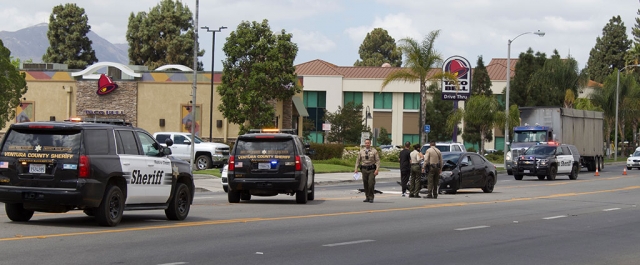 On June 8th, 2021, at 10:50am, Fillmore Police, City Fire and AMR paramedics were dispatched to a traffic collision in front of Carlâs Jr., 754 W Ventura Street. Upon arrival Fire crews reported two vehicles involved with all occupants out. No injuries were reported. Cause of the crash is under investigation. Photos courtesy Angel Esquivel-AE News. Enlarge Photo |




